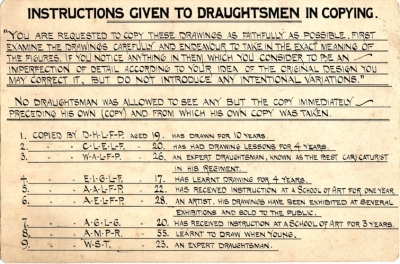To search the RPR site click here
This is an extract from a much longer talk given by Pitt-Rivers at Blackmore Museum, Salisbury, in 1890. This game which he calls Russian Scandal is more commonly called Chinese whispers in England today. The full talk can be found here. More about this drawing game can be found here.
... Ornamentation affords perhaps the best examples of continuous transmutation form that can be found, and ornamental patterns are very persistent in their duration and development. Some patterns introduced quite in pre-historic times have continued to our day. One great cause of the variation of ornamental patterns arises from successive copies, during which errors caused by faulty draughtsmanship have been handed down from one designer to another and exaggerated, until the original pattern has sometimes been completely lost, and some other allied form gradually substituted for it. The process is similar to that by which languages, dialects, music, myths, and even religions, have become changed. In the case of myths or religions or even dialects, the successive changes are very difficult to trace, when they have not been duly recorded, but in the case of ornamental patterns, the changes of form have often been preserved, or the designs have survived in wood or stone, and can be compared with one another. Similar changes in traditional and unwritten records are well exemplified by a game called "Russian Scandal" ****, in which one person introduces a short story, consisting of a few sentences and repeats it in a whisper to his neighbour, who in his turn repeats it to a third person, and so on in succession, until the last person of the party is made to repeat the story, as he heard it from the one before him, and the variation that it has undergone during the process is then compared with the original words, in which the story was introduced. It occurred to me, that the same thing might be done to shew the changes that take place by successive copies of drawings; so I got together ten persons, all of whom had learnt to draw, though of course they varied in their powers of delineation. I exhibit six cards on which their actual performances have been put together. It will be seen that there are six subjects, and ten representations of each. At the top of each series is the drawing made by No. 1., from the original: No. 2. copies from No. 1., and is not allowed to see the original, and so on to No. 10., in which it will be seen, that considerable changes have generally taken place.
This is one of the great causes of variation in ornamental patterns. One of the most usual results produced by these variations is the substitution of the field, or interspace for the pattern itself. This is seen on more than one of the diagrams that I exhibited. ....
Transcribed by AP for the Rethinking Pitt-Rivers project in August 2011.




